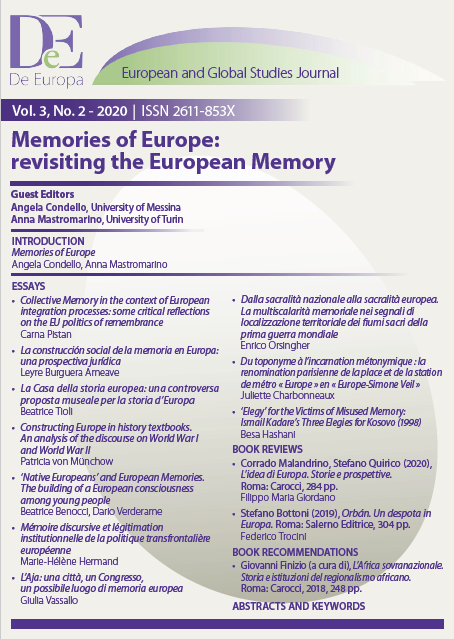La Casa della storia europea: una controversa proposta museale per la storia d’Europa
Abstract
Questo articolo si propone di analizzare la narrativa storica proposta dalla Casa della Storia Europea (HEH), un museo promosso, finanziato e gestito dal Parlamento Europeo. Considerata l’origine politica dell’HEH, si discuterà il ruolo che il museo occupa nelle politiche culturali proposte dalle istituzioni europee al fine di rafforzare un sentimento di identità tra i cittadini dell’Unione. Si analizzerà poi la narrativa proposta dal museo per raccontare la storia europea, a partire delle seguenti domande: a proposito del processo di integrazione, il museo propone un racconto teleologico della storia europea? L’HEH offre ai visitatori una chiara interpretazione dell’identità europea? Si tratta di un luogo aperto al dibattito, in cui si presenta una visione plurale delle conflittuali memorie europee? Quale immagine trasmette dell’Europa multiculturale contemporanea e delle relazioni del continente con il resto del mondo? Quali strategie adotta per raccontare una storia coerente e per gestire le memorie divisive del ventesimo secolo? La tesi che intendo verificare è che il museo non proponga una narrativa teleologica della storia europea, sebbene esso chiaramente rappresenti una “storia di unità” e, in questo modo, trasmetta un forte messaggio a favore di un’Europa unita. Inoltre, si porrà l’attenzione su come l’installazione museale in questione metta in atto con successo un compromesso storiografico tra le memorie contrastanti dell’Europa orientale e occidentale per quanto riguarda il concetto di victimhood dei crimini nazisti e stalinisti. Infine, si analizzerà l’approccio del museo per quanto riguarda alcuni temi controversi come la religione, le migrazioni e le implicazioni post-coloniali della storia europea.
Parole chiave: Musei, storia europea, identità europea, Casa della storia europea, memory studies
The aim of this article is to analyse the historical narrative proposed by the House of European History (HEH), a museum launched, funded, and managed by the European Parliament. Since the HEH is a concrete project, I will discuss its role among the cultural politics proposed by the European Institutions to foster a feeling of identity among the European citizens. Then, I will discuss which kind of narrative of European history the HEH presents, starting from the following guiding questions: concerning the European integration process, does it propose a teleological account of European history? Does it offer a clear interpretation of European identity? Is it a place open to debate that offers a plural view of European conflicting memories? Which image does it convey of today’s multicultural Europe and of the continent’s relations with the rest of the world? Which strategies does the HEH adopt to tell a coherent history and to manage the divisive memories of the 20th Century? The thesis I mean to verify is that the museum does not proposes a teleological narrative of the European history, although it clearly represents a “story of unity” and, in this way, it conveys a strong message in favour of a united Europe. Moreover, I will pay attention to the way in which the exhibition successfully displays a historiographical compromise between the opposing memories of European Eastern and Western states about the notion of victimhood of Nazi and Stalinist crimes. Finally, I will analyse the HEH’s approach to some thorny issues as religion, migrations, and post-colonial implications of the European history.
Keywords: Museum, European history, European identity, House of European history, memory studies



 The journal has been approved for inclusion in DOAJ. The DOAJ listing of the journal is available at
The journal has been approved for inclusion in DOAJ. The DOAJ listing of the journal is available at 
